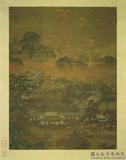宋元集繪 冊 無款秋林策蹇
推薦分享
資源連結
連結到原始資料 (您即將開啟新視窗離開本站)後設資料
- 資料識別:
- 故畫001293N000000001
- 資料類型:
- 類型:繪畫
- 型式:靜態圖像
- 主題與關鍵字:
- 秋景 高士(士人、隱士) 松 騾.驢
- 出版者:
- 數位化執行單位:國立故宮博物院
- 格式:
- 本幅 49.7x38.9公分、對幅 25.2x18.9公分、全幅 60.5x111公分
- 關聯:
- 石渠寶笈三編(延春閣),第五冊,頁2521&*故宮書畫錄(卷六),第四冊,頁230&*「秋林策蹇」為「宋元集繪」冊之第一開,描寫秋景疏曠,遠近各有松、椿樹雜列,一叟頂笠,策馬徐行其間。幅中未見作者款識,而對幅之跋語卻指稱,畫面右上角原本鈐有南宋高宗之紹興小璽,左下角亦有馬和之印記,因遭蟲蝕,故於裝潢後殘缺不全。細審坡陀、枝幹與人物衣紋之線描,固然與南宋畫家馬和之慣採之「馬蝗描」相彷彿,惟筆意略嫌滯澀,極可能是出自後人仿馬之作。&*The scene depicted here describes the clear vastness and melancholy of autumn. Near and far, pines and other ancient trees are interspersed. Among them, an old man wearing a bamboo hat presses his horse slowly onward. There is no signature to be found on the painting, but the postscripts point out that in the upper right hand corner of the composition is the seal of the Sung Emperor Kao-tsung's Shao-hsing era (1131-1162). Also in the lower left corner, the seal of Ma Ho-chih (d. ca. 1190) is apparent. However, because the work was victimized by insects, what remained after remounting was incomplete. Upon close scrutiny of the painting, the fine lines utilized in the depiction of the slopes, terrain, trees and figures are certainly found to be similar to those of the Southern Sung artist Ma Ho-chih. His brushwork is characterized by calligraphic lines which resemble a "leech's body". Judging from the brush style in this work, however, it is very likely that a later artist copied the mannerisms of Ma Ho-chih, as this rendition is suspiciously hesitant in comparison.
- 管理權:
- 國立故宮博物院
授權聯絡窗口
- 國立故宮博物院圖像授權、出版授權、影音資料授權-申請流程說明
http://www.npm.gov.tw/zh-TW/Article.aspx?sNo=03003061






